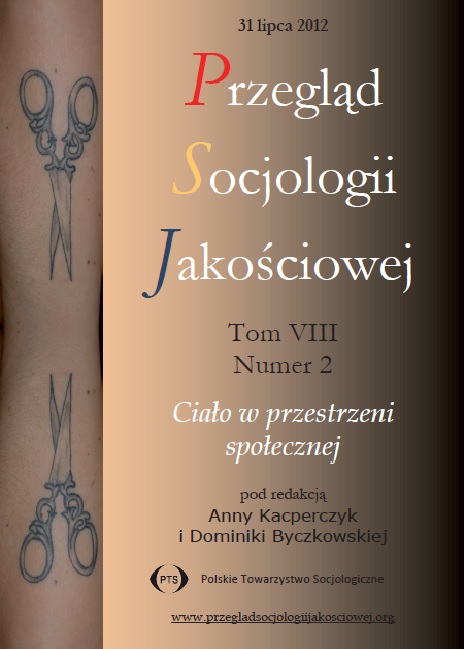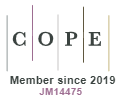“Body as the temple of the soul” – the process of building the identity of hatha-yoga practitioner. Constructing a private quasi-religion
DOI:
https://doi.org/10.18778/1733-8069.8.2.04Keywords:
body, corporeality, yoga, hatha-yoga, yoga practice, religion, quasi-religion, para-religion, identity constructionAbstract
The article addresses the problem of perceiving and experiencing one’s body within the yoga practice. The process of becoming a yogi is related to the practices of the body and to further defining them; next, to the defined perception of the body and its sensations. Becoming a hatha-yoga practitioner is a specific process. In this paper I describe its phases: 1. The introductory phase – constructing the motives and first steps; 2. Phase of the deeper recognition of psycho-physical effects of yoga practice and of attributing them with adequate meanings; 3. Phase of the deeper recognition of hatha-yoga spiritual aspects (quasi-religion). At the moment of significant involvement in hatha-yoga practice and defining corporeal practices in terms of being bodily and mental at the same time, the mind – body rapport compound. The work over the body may transform the Western perspective of defining the body as a substantial element of human existence (Cartesian vision) into treating it as a spiritualized matter (vision of Eastern philosophy). If, however, the tenets of other religions are maintained as one’s own (e.g., catholic religion), the transformation at hand will not proceed. In that case, in order to reconcile the conventional religion tenets with new spiritual experiences, changes in body and mind need to be defined in any other way, and a specific linguistic explanations of these changes (often adopting the scheme of constant linguistic formulas) need to occur.
Downloads
References
Augustyn Aneta (2009) Joga na dobre i złe. „Gazeta Wyborcza” z dn. 20 stycznia 2009 r. [dostęp 10 października 2010 r.]. Dostępny w Internecie http://wyborcza.pl/1,75476,5897236,Joga_na_dobre_i_na_zle.html
Google Scholar
Augustyn Aneta (2010) Joga to jest to! „Gazeta Wyborcza” z dn. 20 listopada 2010 r. [dostęp 12 grudnia 2010 r.]. Dostępny w Internecie http://wyborcza.pl/1,75476,8686452,Joga_to_jest_to_.html
Google Scholar
Berger Peter (2005) Święty Baldachim. Elementy socjologicznej teorii religii. Przełożył Włodzimierz Kurdziel. Kraków: Nomos.
Google Scholar
Eliade Mircea (1997) Joga. Nieśmiertelność i wolność. Przełożył Bolesław Baranowski. Warszawa: PWN.
Google Scholar
Eliade Mircea (2004) Patańdżali i joga. Przełożył Jerzy Prokopiuk. Warszawa: Wydawnictwo KR.
Google Scholar
Eliade Mircea (2009) Techniki jogi. Przełożyła Beata Biały. Warszawa: Wydawnictwo Aletheia.
Google Scholar
Górski Sebastian (2004) Joga krzepi. „Wprost 24”, nr 8/2004 (1108) [dostęp 2 sierpnia 2011 r.]. Dostępny w Internecie http://www.wprost.pl/ar/56385/Jogakrzepi/?I=1108
Google Scholar
Greil Arthur L., Rudy David R. (1984) Social Cocoons: Encapsulation And Identity Transformation Organizations. „Sociological Inquiry”, vol. 54, no. 3, s. 260–278.
Google Scholar
DOI: https://doi.org/10.1111/j.1475-682X.1984.tb00060.x
Greil Arthur L., Bromley David R., eds., (2003) Defining Religion: Investigating the Boundaries Between the Sacred and the Secular. Greenwich: JAI Press.
Google Scholar
Iyengar B.K.S. (1995) Drzewo jogi. Przełożył Sławomir Bubicz. Warszawa: Virya.
Google Scholar
Iyengar B.K.S. (1996) Światło jogi. Przełożył Sławomir Bubicz. Warszawa: Virya.
Google Scholar
Iyengar B.K.S. (1997) Pranajama. Sztuka oddychania w jodze. Przełożyli Sławomir Bubicz, Liliana Pechal. Warszawa: Virya.
Google Scholar
Iyengar B.K.S. (2006) Joga światłem życia. Wewnętrzna podróż ku przemianie. Przełożyła Anna Klajs. Łódź: Galaktyka.
Google Scholar
Joga na Times Square. „Rzeczpospolita” z dn. 23 czerwca 2010 r. [dostęp 28 lipca 2010 r.]. Dostępny w Internecie http://www.rp.pl/artykul/187143,498263.html
Google Scholar
Knoblauch Hubert (2006) „Niewidzialna religia” Thomasa Luckmanna, czyli o przemianie religii w religijność [w:] Thomas Luckmann, red., Niewidzialna religia. Problem religii we współczesnym społeczeństwie. Kraków: Nomos, s. 7–46.
Google Scholar
Konecki Krzysztof T. (2010) Wywiad na podstawie filmów w badaniach praktyki jogi – na przykładzie badań cielesności i gestów w społecznym świecie praktyki jogi [w:] Jacek Leoński, Magdalena Fiternicka-Gorzko, red., Kultury, subkultury i światy społeczne w badaniach jakościowych. Szczecin: Volumina.pl, s. 303–335.
Google Scholar
Kulmatycki Lesław, Burzyński Zdzisław (1999) Opinie studentów na temat ćwiczeń jogi [w:] Krystyna Zatoń, red., Problemy kultury fizycznej w badaniach naukowych. Wrocław: Wydawnictwo AWF.
Google Scholar
Kulmatycki Lesław, Burzyński Zdzisław (2008) Kto uczy hatha-jogi w Polsce? „Kwartalnik Pedagogiczny”, nr 2/2008, s. 157–172.
Google Scholar
Luckmann Thomas (2006) Niewidzialna religia. Problem religii we współczesnym społeczeństwie. Przełożył Lucjan Bluszcz. Kraków: Nomos.
Google Scholar
Madonna i joga (b.d.) Fit.pl. [dostęp 8 lipca 2011]. Dostępny w Internecie http://www.fit.pl/gwiazdyfit/gwiazdy_i_fitness/madonna_i_joga,169,1,0.html
Google Scholar
De Michelis Elizabeth (2008) Modern Yoga: History and Forms [w:] Singleton Marc S., Byrne Jean Yoga in the Modern World. Contemporary Perspectives. New York: Routledge, s. 17–35.
Google Scholar
Nelke Magdalena (2010) Dynamicznie i z optymizmem – branża fitness w Polsce. Podsumowanie wyników ankiety „Analiza rynku fitness 2010”. „Body Life”, nr 4/2010 [dostęp 4 lutego 2011 r.]. Dostępny w Internecie http://www.fit.pl/g/str/file/ankieta_fitness.pdf
Google Scholar
Pereira Joseph (2010) Jogin w Kościele. Rozmowę przeprowadził Łukasz Ziółkowski. „Tygodnik Powszechny”, nr 22(3177) z dn. 30 maja 2010 r. [dostęp 6 czerwca 2010 r.]. Dostępny w Internecie http://tygodnik.onet.pl/32,0,47025,jogin_wkosciele,artykul.html
Google Scholar
DOI: https://doi.org/10.1007/BF03088840
Pilorz Katarzyna (2008) Radość z jogi. Rozmowę przeprowadziła Zofia Rokita. „Rzeczpospolita” z dn. 16 listopada 2008 r. [dostęp 4 lutego 2011 r.]. Dostępny w Internecie http://www.rp.pl/artykul/220001.html
Google Scholar
Prus Robert (2009) Reconceptualizing the Study of Community Life: Emile Durkheim’s Pragmatism and Sociology. „The American Sociologist”, vol. 40, no. 1–2, s. 106–146.
Google Scholar
DOI: https://doi.org/10.1007/s12108-009-9066-1
Rokita Zofia (2008) Skręty są dobre na umysł. „Rzeczpospolita” z dn. 7 listopada 2008 r. [dostęp 4 lutego 2011 r.]. Dostępny w Internecie http://www.rp.pl/artykul/215866.html
Google Scholar
Rudy David R., Grail Arthur R. (1989) Is Alcoholics Anonymous a Religious Organization?: Meditations on Marginality. „Sociology of Religion”, vol. 50, no. 1, s. 41–51.
Google Scholar
DOI: https://doi.org/10.2307/3710917
Scherer Burkhard (2009) Buddyzm. Przełożył Grzegorz Kuśnierz. Kęty: Wydawnictwo Marek Derewiecki.
Google Scholar
Seung Sahn (2006) Strzepując popiół na Buddę. Przełożyli Jacek Szepan, Antoni Szoska. Warszawa: Szkoła Zen Kwan Um w Polsce.
Google Scholar
Staszewski Wojciech (2009) Siła spokoju. „Gazeta Wyborcza” z dn. 30 grudnia 2009 r. [dostęp 10 października 2010 r.]. Dostępny w Internecie http://wyborcza.pl/1,99149,7408468,Sila_spokoju.html?as=3&startsz=x#ixzz11xTm9KJd
Google Scholar
Stein Jeannine (2010) Yoga may be better at reducing anxiety and lifting mood than other forms of exercise, study finds. „Los Angeles Times”, November 11 [dostęp 5 sierpnia 2011 r.]. Dostępny w Internecie http://articles.latimes.com/2010/nov/11/news/la-hebyoga-20101111
Google Scholar
Wilson Bryan R. (1992) The social dimension of sectarianism: sects and new religious movements in contemporary society. New York: Oxford University Press.
Google Scholar
Zotz Volker (2007) Historia filozofii buddyjskiej. Przełożyła Monika Nowakowska. Kraków: Wydawnictwo WAM.
Google Scholar
Downloads
Published
How to Cite
Issue
Section
License

This work is licensed under a Creative Commons Attribution-NonCommercial-NoDerivatives 4.0 International License.














